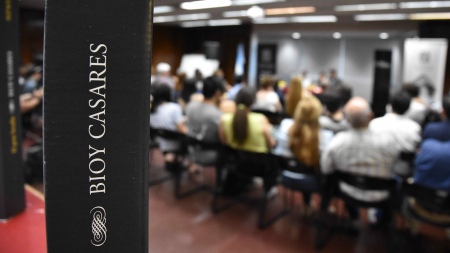With new editions and covers by prestigious Argentine photographers, The Alfaguara publishing house launched “Todo Bioy”, an initiative presented this Tuesday at the National Library that condenses all the stories, essays and novels of Adolfo Bioy Casares in 15 volumes that will give new meaning to the narrative power and anticipatory character that distinguished the writing of the winner of the 1990 Cervantes Prize, friend and creative ally of Jorge Luis Borges.
Julieta Obedman, literary director of the Alfaguara publishing house, told Télam that the initiative seeks to “offer readers individual books within an author Library” with the aim of awakening interest in a new audience and also to provide them with those books that connoisseurs of the famous writer have not yet read. “For this reason, the idea is to go out at the same time with the entire Library, which is also a way of communicating the importance that Alfaguara gives to his work, in line with what we have been doing with authors such as Julio Cortázar, Roberto Bolaño, José Saramago”, explained the editor.
“Todo Bioy” unfolds into 15 books with covers of black and white photographs by renowned Argentine photographers like Aldo Sessa, Horacio Coppola, Sofía López Mañán, Pedro Raota, Oscar Pinto. For the launch, held in the Augusto R. Cortázar room of the National Library, the publisher decorated one end of the room with gigantographs of the volumes. “From the beginning we thought of working with Argentine photographers; and Horacio Coppola seemed like a natural choice, because he is a photographer who deals with Buenos Aires and because he is a contemporary of Bioy. From there the search was extended to other photographers, but the white and “black seemed to us to define a collection well. Fortunately, many national photographers use black and white, so we ended up deciding on that aesthetic line,” Obedman said.

Alfaguara’s initiative covers his best-known novels and volumes of short stories, such as “The Invention of Morel”, “Diary of the Pig’s War”, “The Dream of Heroes”, “Sleep in the Sun”, “The Celestial Plot” or “The shadow side”), as well as less frequented titles (“Garland with loves”, “The great Seraph”).
He also unfolds his latest short stories into two volumes (“Unbridled Stories”, “A Russian Doll” and “A Modest Magic”) and his novels “The adventure of a photographer in La Plata”, “An unequal champion” and “Of a world to another”. It also includes his “Memoirs”, illustrated with photos, as well as a volume of essays entitled “The other adventure and other writings”.
Along with Jorge Luis Borges and the writers most associated with the Boom of the 1960s (Julio Cortázar, Ernesto Sábato), Bioy Casares (1914-1999) was one of the most relevant authors of 20th-century Argentine literature. His narrative work earned him various awards, such as the Grand Prize of Honor from the Argentine Society of Writers (SADE) in 1975 and the Cervantes Prize in 1990. Many of his books were made into movies: “El perjurio de la nieve” (with the title of “Oribe’s crime”), “Diary of the pig’s war” (directed by Leopoldo Torre Nilsson) and “The dream of heroes” (directed by Sergio Renán).
Until some time ago, his Complete Work circulated divided into three voluminous volumes that were meticulously reviewed by Ernesto Montequin and Daniel Martino, who agreed on this diversification into 15 books that will allow an agile circulation of the work and certain reading facilities.

During the presentation, Esther Cross and the writers Carlos Gamerro and Gonzalo Garcés shared keys to approach their work, biographical data of the author and reading experiences. In the case of the author of “El miedo” and “Los impatientes”, who rediscovered the books by Bioy Casares after many years, he recognized that the experience “was very different” from when he was little and was encouraged to outline a hypothesis : “Bioy’s literature is a cheat literature”.
To develop this idea, Garcés explained: “We know that he was a cute, handsome, seductive and very womanizing guy, very unfaithful but also extremely shy, who found it difficult to say what he really felt” and added that, after the publication of the writer’s diaries “many people had breakfast with rather derogatory remarks from Bioy when they were used to a very cordial treatment”.
In this way, the work of Borges’s great friend and literary accomplice inhabits the idea that “our individual identity is not as monolithic as we usually believe,” Garcés pointed out and assured: “This was expressed by Bioy in ‘In memory of Paulina’ “. The story -which is included in the book “La plot celestial” and was originally published in 1948- tells the first-person story of a man who has been in love with a girl since childhood, described as a perfect woman. “In everything in which the narrator resembled Paulina, there was the best of him,” said Garcés.
“From that childhood love and as they grow, the narrator supposes that they are going to get married but this does not happen because Paulina marries Julio Montero, who -like the narrator- is a writer who is gross, full of places common. An undesirable”, recovers Garcés. At the time, Paulina reappears in the life of the lover and they live “an afternoon of reunion”. However, the narrator notices that Paulina speaks like Montero. As the story progresses, the idea begins to emerge that in reality the author would not have met Paulina in the flesh but rather “with a projection that Montero made of that meeting.” Montero, upon discovering the meeting between the lovers, had murdered Paulina. “Montero’s jealousy, imagining how it was going to be, was so strong that it was embodied in that Paulina who appeared in the narrator’s bed,” Garcés conjectured. “What happens if the image that Paulina has of the narrator is just as false as the person I love Or what I project myself? It’s a very lonely idea of love, but it’s one of the ideas I had,” the speaker reflected.

Another story by Bioy Casares that Garcés used to explain his point was “La plot celeste” as “another story that occurs to a person, accustomed by his experience, to living in several dimensions at the same time”, and that “has as premise the experience of inhabiting different realities through the character of Captain Ireneo Morris, who after suffering an accident while driving an airplane, enters a parallel universe, with similarities and slight variations of the City of Buenos Aires and his daily life”.
“Well, I’m Carlos Gamerro,” he joked when Esther Cross introduced himself, in tune with Bioy Casares’ desire to disrupt the order of reality. “At the same time a great writer and a guide, Bioy is a writer who feels very close. Going back to what Gonzalo said about the literature of the trap, I think that Casares beyond that had a great literary project and was very loyal to that project,” Cross said.
“Sometimes we readers tend to think that writers always speak figuratively, that everything they say is metaphorical, a play on words. It seems to me that when he said he was looking to extend his season on Earth, The best writing was going to find a way and I wasn’t speaking metaphorically,” Cross observed, adding: “I think wryly, romantically, a little jokingly, a little seriously, he talks about seeking immortality by book.”

The author of “La señorita Porcel” chose the story “El perjurio de la nieve” because it is an “Aleph” of the work of the honored writer, since many themes that he addressed are condensed. Cross highlighted the story of doubles that works in the story and the theme of plagiarism.
For his part, Gamerro, writer, critic and literary translator, pointed out: “If Bioy is in one of these parallel realities, he must be very happy. In addition, he is of an elegance very worthy of Bioy ”. Later, he began to talk about “La invención de Morel” as “our first Argentine science fiction novel” and “the strongest card” due to its narrative structure.
“Bioy’s peculiarity is that there are always two planes of reality: one that can be objectual, and another that belongs to perception: cinema, dreams, mirrors, hallucinations”Gamerro noted. In addition, he highlighted: “Something that seems very revolutionary about Bioy is that, although the explanation is as logical as that of any detective story, the causalities are magical, supernatural or belong to science fiction”, unlike what is repeated in the traditional police genre as in the case of “The Hound of the Baskervilles” by Arthur Conan Doyle. “You learn a lot by reading Bioy, it’s not just a pleasant read,” the writer concluded.


















